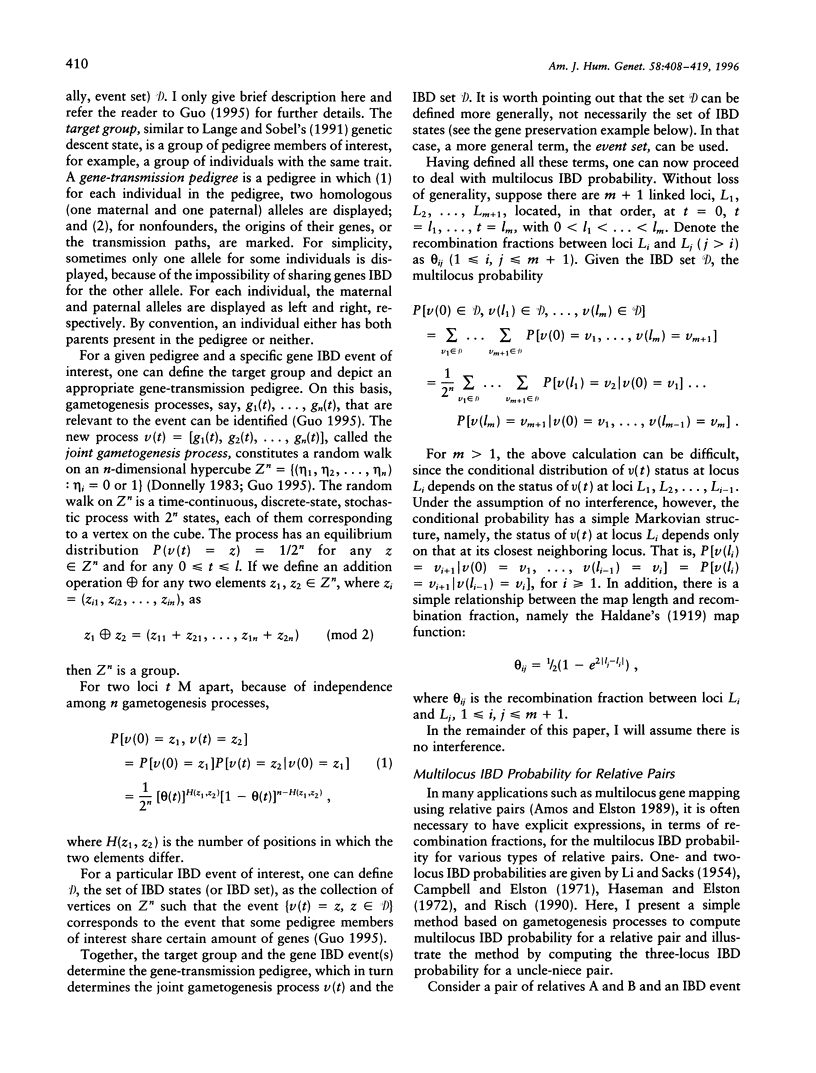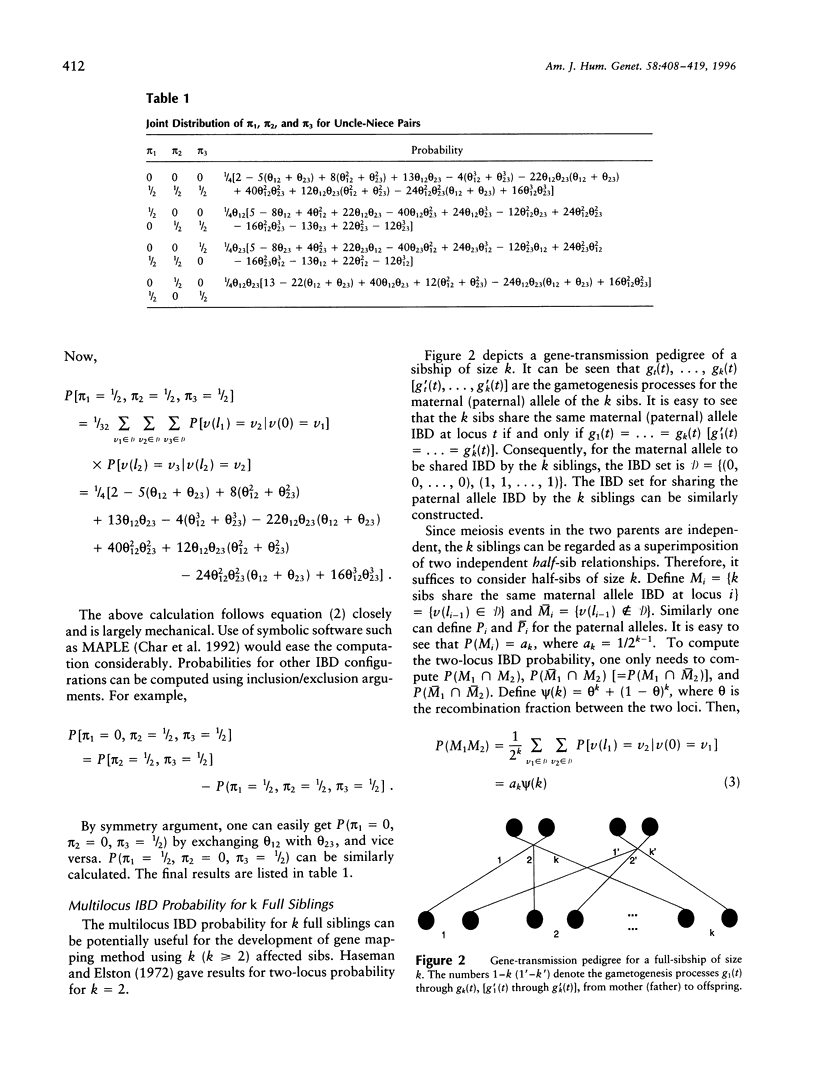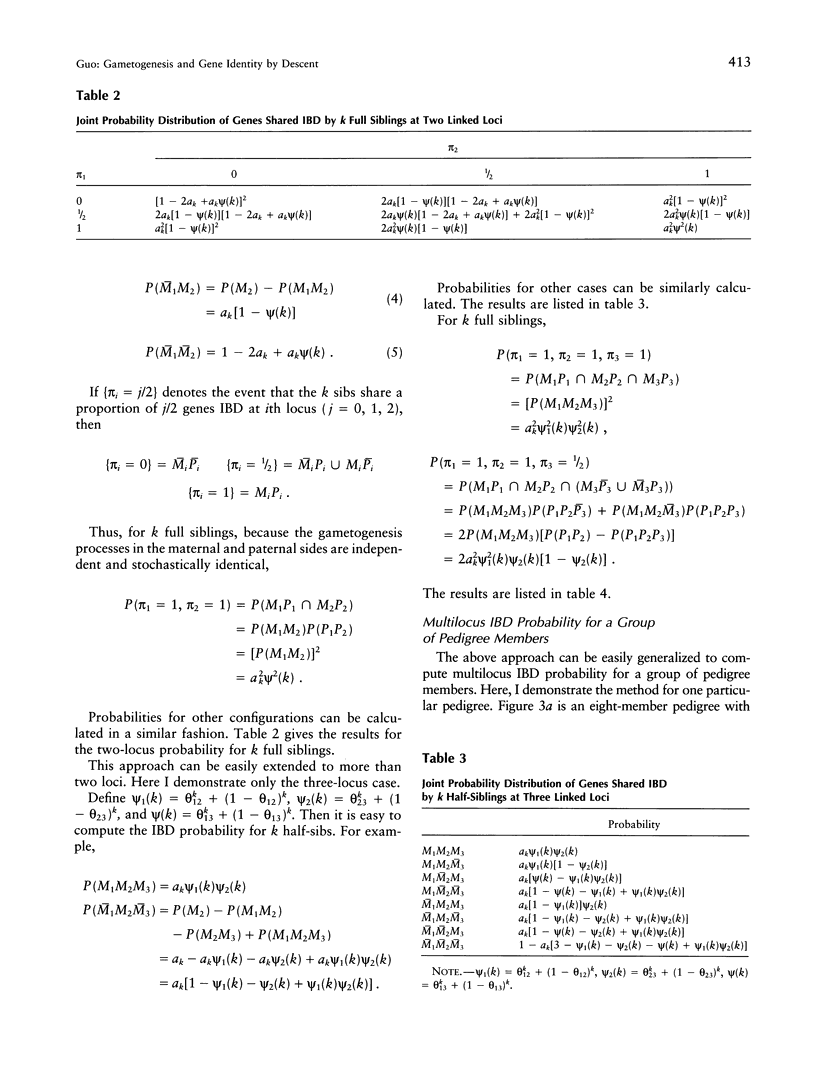Abstract
With few exceptions, the determination of unconditional probability of genes shared identical by descent (IBD) by relatives can be very difficult, especially if the relationship is complex or if multiple loci are involved. It is particularly difficult if one needs the IBD probability in a explicit form, expressed in terms of interlocus recombination fractions. In this paper, I will further extend the concept of gametogenesis process introduced elsewhere and indicate that it completely determines the gene IBD events of interest in pedigrees. I will demonstrate that the gametogenesis process not only serves as a convenient conceptual framework in considering IBD events in pedigrees but also provides a simple yet powerful tool to solve a wide range of seemingly difficult problems. In particular, I consider the problem of multilocus IBD probability for relative pairs, k siblings, and a group of pedigree members. In addition, I consider the problem of multilocus autozygosity probability and the problem of gene preservation in close relatives.
Full text
PDF











Selected References
These references are in PubMed. This may not be the complete list of references from this article.
- Amos C. I., Dawson D. V., Elston R. C. The probabilistic determination of identity-by-descent sharing for pairs of relatives from pedigrees. Am J Hum Genet. 1990 Nov;47(5):842–853. [PMC free article] [PubMed] [Google Scholar]
- Amos C. I., Elston R. C. Robust methods for the detection of genetic linkage for quantitative data from pedigrees. Genet Epidemiol. 1989;6(2):349–360. doi: 10.1002/gepi.1370060205. [DOI] [PubMed] [Google Scholar]
- Campbell M. A., Elston R. C. Relatives of probands: models for preliminary genetic analysis. Ann Hum Genet. 1971 Oct;35(2):225–236. doi: 10.1111/j.1469-1809.1956.tb01395.x. [DOI] [PubMed] [Google Scholar]
- Cockerham C. C. Higher order probability functions of identity of allelles by descent. Genetics. 1971 Oct;69(2):235–246. doi: 10.1093/genetics/69.2.235. [DOI] [PMC free article] [PubMed] [Google Scholar]
- Denniston C. An extension of the probability approach to genetic relationships: one locus. Theor Popul Biol. 1974 Aug;6(1):58–75. doi: 10.1016/0040-5809(74)90031-8. [DOI] [PubMed] [Google Scholar]
- Donnelly K. P. The probability that related individuals share some section of genome identical by descent. Theor Popul Biol. 1983 Feb;23(1):34–63. doi: 10.1016/0040-5809(83)90004-7. [DOI] [PubMed] [Google Scholar]
- Foss E., Lande R., Stahl F. W., Steinberg C. M. Chiasma interference as a function of genetic distance. Genetics. 1993 Mar;133(3):681–691. doi: 10.1093/genetics/133.3.681. [DOI] [PMC free article] [PubMed] [Google Scholar]
- HARRIS D. L. GENOTYPIC COVARIANCES BETWEEN INBRED RELATIVES. Genetics. 1964 Dec;50:1319–1348. doi: 10.1093/genetics/50.6.1319. [DOI] [PMC free article] [PubMed] [Google Scholar]
- Hamilton W. D. The genetical evolution of social behaviour. II. J Theor Biol. 1964 Jul;7(1):17–52. doi: 10.1016/0022-5193(64)90039-6. [DOI] [PubMed] [Google Scholar]
- Haseman J. K., Elston R. C. The investigation of linkage between a quantitative trait and a marker locus. Behav Genet. 1972 Mar;2(1):3–19. doi: 10.1007/BF01066731. [DOI] [PubMed] [Google Scholar]
- KEMPTHORNE O. The correlations between relatives in random mating populations. Cold Spring Harb Symp Quant Biol. 1955;20:60-75; discussion, 75-8. doi: 10.1101/sqb.1955.020.01.008. [DOI] [PubMed] [Google Scholar]
- Karigl G. A recursive algorithm for the calculation of identity coefficients. Ann Hum Genet. 1981 Jul;45(Pt 3):299–305. doi: 10.1111/j.1469-1809.1981.tb00341.x. [DOI] [PubMed] [Google Scholar]
- Kruglyak L., Daly M. J., Lander E. S. Rapid multipoint linkage analysis of recessive traits in nuclear families, including homozygosity mapping. Am J Hum Genet. 1995 Feb;56(2):519–527. [PMC free article] [PubMed] [Google Scholar]
- Lander E. S., Botstein D. Homozygosity mapping: a way to map human recessive traits with the DNA of inbred children. Science. 1987 Jun 19;236(4808):1567–1570. doi: 10.1126/science.2884728. [DOI] [PubMed] [Google Scholar]
- Lander E. S. Finding similarities and differences among genomes. Nat Genet. 1993 May;4(1):5–6. doi: 10.1038/ng0593-5. [DOI] [PubMed] [Google Scholar]
- Lander E. S., Schork N. J. Genetic dissection of complex traits. Science. 1994 Sep 30;265(5181):2037–2048. doi: 10.1126/science.8091226. [DOI] [PubMed] [Google Scholar]
- Lange K., Sinsheimer J. S. Calculation of genetic identity coefficients. Ann Hum Genet. 1992 Oct;56(Pt 4):339–346. doi: 10.1111/j.1469-1809.1992.tb01162.x. [DOI] [PubMed] [Google Scholar]
- Lange K., Sobel E. A random walk method for computing genetic location scores. Am J Hum Genet. 1991 Dec;49(6):1320–1334. [PMC free article] [PubMed] [Google Scholar]
- Risch N., Lange K. Application of a recombination model in calculating the variance of sib pair genetic identity. Ann Hum Genet. 1979 Oct;43(2):177–186. doi: 10.1111/j.1469-1809.1979.tb02010.x. [DOI] [PubMed] [Google Scholar]
- Risch N. Linkage strategies for genetically complex traits. II. The power of affected relative pairs. Am J Hum Genet. 1990 Feb;46(2):229–241. [PMC free article] [PubMed] [Google Scholar]
- Thompson E. A. Gene identities and multiple relationships. Biometrics. 1974 Dec;30(4):667–680. [PubMed] [Google Scholar]
- Weeks D. E., Lange K. The affected-pedigree-member method of linkage analysis. Am J Hum Genet. 1988 Feb;42(2):315–326. [PMC free article] [PubMed] [Google Scholar]
- Whittemore A. S., Halpern J. Probability of gene identity by descent: computation and applications. Biometrics. 1994 Mar;50(1):109–117. [PubMed] [Google Scholar]
- Zhao H., Speed T. P., McPeek M. S. Statistical analysis of crossover interference using the chi-square model. Genetics. 1995 Feb;139(2):1045–1056. doi: 10.1093/genetics/139.2.1045. [DOI] [PMC free article] [PubMed] [Google Scholar]


